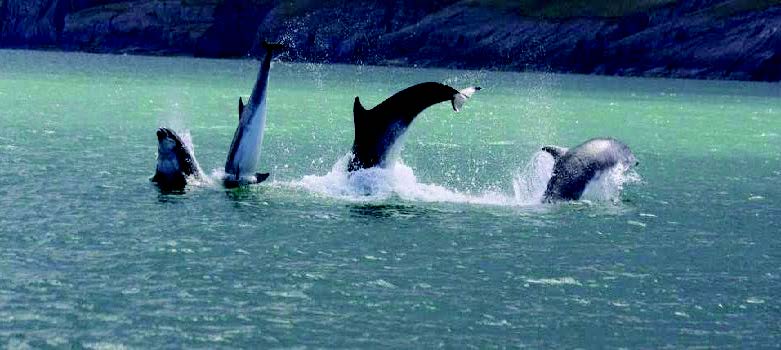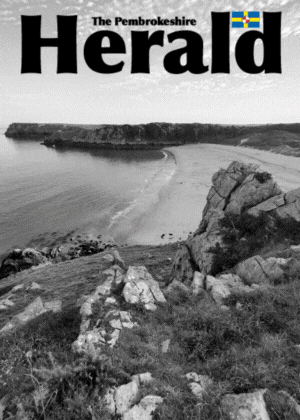News
Controversy over scallop dredgers

 A PETITION aiming to stop scallop dredging grounds from being extended in Cardigan Bay has received over 15,000 signatures, following criticism of a Welsh Government consultation. However, fishermen who have seen a lucrative ground closed for what will be at least seven years have claimed that extensive scientific studies carried out on the grounds since 2010 indicate that there is room for a sustainable fishery. The SAC (Special Area of Conservation) in Cardigan Bay is a traditional scallop fishery, which was closed in 2009 following concerns about the environmental impact of an influx of boats.
A PETITION aiming to stop scallop dredging grounds from being extended in Cardigan Bay has received over 15,000 signatures, following criticism of a Welsh Government consultation. However, fishermen who have seen a lucrative ground closed for what will be at least seven years have claimed that extensive scientific studies carried out on the grounds since 2010 indicate that there is room for a sustainable fishery. The SAC (Special Area of Conservation) in Cardigan Bay is a traditional scallop fishery, which was closed in 2009 following concerns about the environmental impact of an influx of boats.
A small area of Cardigan Bay – The ‘Kaiser Box’ is opened for fishing during the scallop season (Nov – Apr). This has been overfished, to the extent where some local boats are fishing alternative locations or for different catches. It is also claimed, both anecdotally and by scientists involved with the ‘test fishing’ that scallop stocks outside of the Kaiser Box are thriving to the extent where they are potentially unable to reach full growth and are leading to a reduction in biodiversity. The Welsh Government proposes to introduce a ‘managed fishery’ where areas of Cardigan Bay between three and 12 miles out to sea would be fished, with limits imposed on the number of times per season that each patch is dredged, restrictions on equipment used, and flexible restrictions based on the results of regular monitoring. A consultation was launched in November, but relaunched following criticism of the clarity of an online version, and a technical error. This area of Cardigan Bay was said by the Welsh Government to be mostly shallow water where the sand sea-bed was susceptible to ‘wave shaping’.
Test fishing carried out by scientists from Bangor University among others showed that, in the words of the Welsh Government report: ‘This experiment concluded that, as scallop intensity increased, the negative effects on the animal community also increased such that the abundance (i.e. number) and biomass (i.e. weight) of organisms per unit area of the seabed declined. ‘However, these effects were relatively minor and short – lived and were reversed in the period between May and September in the same year (note this would also coincide with the closed season for some scallop fisheries).
‘Depending on the sediment type, the abundance and biomass of benthic species (particularly the prey for fish) had increased in areas with the highest scallop dredging intensity. This may have occurred due to the removal of scallops which constitute the dominant fauna (in biomass) within the areas studied – i.e. through the removal of the main competitor for food. ‘Thus the effects of scallop dredging on prey species for fish do not appear to be a cause for concern. For most areas of the seabed, the physical effects of scallop dredging were no longer present 12 months later. There were two exceptions to this – one more cobbly area of seabed close to the 3 nautical mile zone that had been fished with an intensity of between 3 and 4 times fished, and one area in the 6-12 nautical mile zone that had been fished slightly more than 6 times (these figures are derived from averaging the fishing intensity across the experimental fishing area). Now that the location of these areas has been identified, the Welsh Government will be in a position to protect them by way of spatial restrictions’.
However, environmental writer George Monbiot rubbished these claims. In an ‘emotive’ article, entitled The Dolphin Killers of Cardigan Bay, which appeared in the Guardian last month as an opinion piece, Mr Monbiot made the claim that because the sea beds in Cardigan Bay had been dredged and trawled for years, they were likely to take ‘decades if not centuries’ to recover their former biodiversity, and as such, the Bangor University Study was flawed. One scientist was quoted as suggesting that if you failed to mow your lawn for five years, you would not end up with a first-growth oak forest. While this is true, it does seem to be a somewhat trite statement in this context. Mr Monbiot made some very valid points.
The effects of beam trawling and dredging on certain sea beds, especially coral and reefs, is devastating, and these are widely regarded as two of the more destructive forms of fishing in terms of environmental impact. However, claims about the damage to cuter varieties of marine fauna were not sufficiently explained. However, ‘The people who may be interfering with the Dolphins’ food chain in Cardigan Bay’ lacks the same impact as a headline. This article was linked to the Change.org petition. This also begs the question of where these dolphins were when the grounds were being fished before. Because this is an emotive subject, no fishermen were willing to be interviewed on the record, but no one The Herald talked to had noticed an increase or decrease in the number of dolphins and porpoises in Cardigan Bay over the last decade.
Whether Mr Monbiot had data illustrating this or not is open to question, but one would think that data which proved the main hypothesis of the article would have been reproduced, or footnoted. A number of fishermen expressed their frustrations that following one of the most detailed assessments into the impact of scallop fishing, that a consultation based on this has been extended. The Herald was told that it was in the interests of fishermen to work within any Government-imposed restrictions, both to continue fishing, and to make sure that the industry was sustainable. Many of those commenting on the petition seemed to imply that eco tourism or alternative fishing methods could replace the dredging industry, or such of it as remains. To some extent the latter has occurred naturally in this area; notably fewer scallop boats have been seen in Milford Docks, for example, this winter, at least partly as a result of poor catches in the permitted area.
The overlap between commercial fishing and eco-tourism probably looks a lot clearer from the perspective of a holidaymaker, though it is hard to see how many transferable skills there would be between the two, and while diving for scallops may be the preferred method, the yields using this method equate to a small percentage of the total scallop catch, thought to be worth between £5 and 6mfrom Cardigan Bay alone. To respond to the relaunched Welsh Government consultation, visit: http://gov.wales/consultations/ e n v i r o n m e n t a n d c o u n t r y s i d e / p r o p o s e d – n e w – m a n a g e m e n t – measures-for-the-scallop-fisheryin- cardigan-bay/?lang=en To sign the change.org petition, visit their website and search for Cardigan Bay.
Crime
Pembrokeshire man sent to Crown Court over death by careless driving charge

A PEMBROKESHIRE man has been sent to the Crown Court to stand trial accused of causing a death by careless or inconsiderate driving.
Alexander MacCallum, aged 28, of Beach Road, Llanreath, Pembroke Dock, appeared before Llanelli Magistrates’ Court on Wednesday (Dec 18).
The court heard that MacCallum is charged with causing death by careless or inconsiderate driving following an incident on Thursday (June 13, 2024).
No plea was entered at this stage of the proceedings.
Magistrates were told the case was too serious to be dealt with at magistrates’ level and ordered that it be sent to the Crown Court for trial.
MacCallum was sent to the Crown Court on unconditional bail, with further proceedings to take place at a later date.
The prosecution was brought by Dyfed-Powys Police. No defence solicitor was formally recorded at the hearing.
Health
NHS Wales spends more than £15.5m on agency radiographers as pressures grow

NHS WALES has spent more than £15.5 million on agency radiography staff over the past five years, as mounting pressure on diagnostic imaging services raises concerns about long-term workforce sustainability.
Figures obtained by the Welsh Liberal Democrats through Freedom of Information requests show that spending on temporary radiographers almost doubled between 2020/21 and 2023/24, despite relatively low headline vacancy rates across Welsh health boards.
Radiographers carry out X-rays, CT, MRI and ultrasound scans, which are essential to emergency care, cancer diagnosis, trauma treatment and elective surgery. Delays or shortages in imaging services can have a knock-on effect across patient pathways, slowing diagnosis and treatment.
The data also highlights an ageing workforce. More than a quarter of radiographers in Wales are aged over 50, with more than one in ten aged 55 or above. In some health boards, a significantly higher proportion of staff are approaching retirement age, raising concerns that experienced radiographers could leave faster than they can be replaced.
Betsi Cadwaladr University Health Board recorded the highest agency spend, at more than £8.1m over the period covered by the FOI requests. Other health boards also reported growing reliance on temporary staff to maintain services, particularly where specialist skills are required.
While official vacancy figures remain comparatively low, professional bodies have previously warned that vacancy data does not always reflect pressure on services, as posts can be held open or covered through overtime and agency staff rather than filled permanently.
Diagnostic imaging demand has increased steadily in recent years, driven by an ageing population, advances in medical imaging technology, and rising referrals linked to cancer and long-term conditions.
Commenting on the findings, Welsh Liberal Democrat Leader Jane Dodds MS said:
“Radiographers are absolutely vital to the NHS. From diagnosing cancer to treating people in A&E, the vast majority of patient journeys depend on timely access to scans.
“These figures show a system increasingly relying on expensive agency staff while failing to plan properly for the future workforce. That is not fair on patients, and it is not fair on staff who are already under huge pressure.
“The Welsh Labour Government must take urgent action to improve recruitment and retention, support experienced staff to stay in the workforce for longer, and ensure NHS Wales has a sustainable radiography workforce fit for the future.”
The Welsh Government has previously said it is working with health boards to improve recruitment and retention across NHS Wales, including expanding training places and supporting flexible working arrangements to help retain experienced staff. Ministers have also pointed to record numbers of staff working in the NHS overall, while acknowledging ongoing challenges in hard-to-recruit specialties.
However, opposition parties and professional bodies continue to warn that without long-term workforce planning, reliance on agency staff could increase further, adding to costs and pressure on already stretched diagnostic services.
Local Government
Essential bridge maintenance and repairs planned for January

Works on Westfield Pill Bridge to affect A477 traffic
ESSENTIAL maintenance and repair work is set to begin on Westfield Pill Bridge, with traffic management in place on the A477 between Neyland and Pembroke Dock.
The programme of works is due to start on Monday (Jan 19) following a Principal Inspection carried out in 2022, which identified a number of necessary repairs to maintain the long-term durability and safety of the structure.
Westfield Pill Bridge is a key route linking communities in south Pembrokeshire and carries a high volume of daily traffic. While major works were last undertaken in 1998 — which required a full closure of the bridge — the upcoming refurbishment has been designed to avoid shutting the crossing entirely.
Instead, the works, scheduled to take place in early 2026, will be managed through traffic control measures to keep the bridge open throughout the project.
The planned refurbishment will include the replacement of both eastbound and westbound bridge parapets, the renewal of expansion joints, and full resurfacing of the bridge deck.
The work is expected to take no longer than three months and will involve weekend and night-time working to help minimise disruption. All construction activity will be carried out from the bridge deck and has been scheduled to avoid clashes with other planned trunk road works, as well as periods of higher traffic demand.
Two-way traffic signals will be in place for the duration of the works. These will be manually controlled during peak periods, with particular efforts made to reduce delays affecting school transport.
Motorists are advised that there may be delays to local bus services during the works, including the 349 (Haverfordwest–Pembroke Dock–Tenby) and 356 (Milford Haven–Monkton) routes.
Drivers are encouraged to allow extra time for journeys and to follow on-site signage while the works are underway.
-

 Crime1 day ago
Crime1 day agoMilford Haven man jailed after drunken attack on partner and police officers
-

 News4 days ago
News4 days agoDyfed-Powys Police launch major investigation after triple fatal crash
-

 Crime1 day ago
Crime1 day agoTeenager charged following rape allegation at Saundersfoot nightclub
-

 Crime2 days ago
Crime2 days agoMan charged with months of coercive control and assaults
-

 Crime3 days ago
Crime3 days agoMan sent to Crown Court over historic indecent assault allegations
-

 Crime5 days ago
Crime5 days agoMan spared jail after baseball bat incident in Milford Haven
-

 Crime3 days ago
Crime3 days agoMilford Haven man admits multiple offences after A477 incident
-

 Crime2 days ago
Crime2 days agoWoman ‘terrified in own home’ after ex breaches court order



















